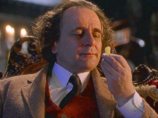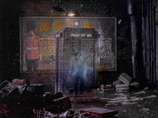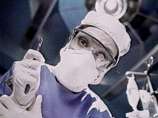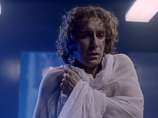 |
|
The Seventh Doctor
|
|
 The Master has been tried on Skaro and has been found guilty of a ‘list of evil crimes’. His death sentence, at the hands of the Daleks, has been carried out but his last wish was for his remains to be returned to Gallifrey by his archenemy - The Doctor. And so in the TARDIS control room, the Seventh Doctor places the urn containing The Master’s remains into a casket and locks it with his sonic screwdriver. This done he rests by listening to a record, with a cup of tea and a book while the TARDIS heads for Gallifrey. The Master has been tried on Skaro and has been found guilty of a ‘list of evil crimes’. His death sentence, at the hands of the Daleks, has been carried out but his last wish was for his remains to be returned to Gallifrey by his archenemy - The Doctor. And so in the TARDIS control room, the Seventh Doctor places the urn containing The Master’s remains into a casket and locks it with his sonic screwdriver. This done he rests by listening to a record, with a cup of tea and a book while the TARDIS heads for Gallifrey.
 Unknown to The Doctor however, the casket starts to shudder. At the same time The Doctor’s cup of tea falls to the ground and the record becomes stuck playing the same part of the song over-and-over again. The casket then cracks open, releasing a jelly-like substance which swiftly moves to the TARDIS control console, vanishing inside. The console then starts to malfunction and, despite The Doctor’s attempts to stabilise it, a warning is given of a critical timing malfunction and the TARDIS prepares for an emergency landing. Unknown to The Doctor however, the casket starts to shudder. At the same time The Doctor’s cup of tea falls to the ground and the record becomes stuck playing the same part of the song over-and-over again. The casket then cracks open, releasing a jelly-like substance which swiftly moves to the TARDIS control console, vanishing inside. The console then starts to malfunction and, despite The Doctor’s attempts to stabilise it, a warning is given of a critical timing malfunction and the TARDIS prepares for an emergency landing.
 On Earth, in San Francisco on the 30th December 1999, a group of youths – Chang Lee and two others – are being chased by a car. They scale a fence into a yard and believe themselves safe, but a group of armed thugs emerge from hiding. Suddenly a wind blows up and the TARDIS materialises in front of Chang Lee. The door opens and The Doctor exits, to be met by a hail of bullets. A car then pulls up and the gang members depart, leaving Chang Lee with the prone figure of The Doctor. As Chang Lee calls for an ambulance The Doctor is powerless as he witnesses a jelly-like substance emerge from the TARDIS’s keyhole. On Earth, in San Francisco on the 30th December 1999, a group of youths – Chang Lee and two others – are being chased by a car. They scale a fence into a yard and believe themselves safe, but a group of armed thugs emerge from hiding. Suddenly a wind blows up and the TARDIS materialises in front of Chang Lee. The door opens and The Doctor exits, to be met by a hail of bullets. A car then pulls up and the gang members depart, leaving Chang Lee with the prone figure of The Doctor. As Chang Lee calls for an ambulance The Doctor is powerless as he witnesses a jelly-like substance emerge from the TARDIS’s keyhole.
 | | The TARDIS Materialises |
|
 The Doctor is taken to a hospital, in the ambulance, by a medic named Bruce. On arriving there The Doctor is rushed into surgery, while in the ambulance a jelly-like snake hides itself in Bruce’s jacket. Inside the hospital the medical staff are astonished to discover that The Doctor’s X-rays show’s him to have two hearts. The hospital’s cardiologist, Dr Grace Holloway, arrives at the hospital and prepares to operate on The Doctor. In surgery she starts to probe the heart of the apparently unconscious patient, but The Doctor wakes and as he starts to struggle he is quickly anaesthetised. Dr Grace Holloway finds that she cannot recognise the internal structure of The Doctor’s body and experimentally pushes the probe hard. The Doctor convulses and his life-signs vanish from the monitors. The death of her patient upsets Dr Grace Holloway and she demands to see the X-rays. Chang-Lee, waiting outside, is summoned and, after being told of The Doctor’s death, he is given The Doctor’s possessions. The Doctor is taken to a hospital, in the ambulance, by a medic named Bruce. On arriving there The Doctor is rushed into surgery, while in the ambulance a jelly-like snake hides itself in Bruce’s jacket. Inside the hospital the medical staff are astonished to discover that The Doctor’s X-rays show’s him to have two hearts. The hospital’s cardiologist, Dr Grace Holloway, arrives at the hospital and prepares to operate on The Doctor. In surgery she starts to probe the heart of the apparently unconscious patient, but The Doctor wakes and as he starts to struggle he is quickly anaesthetised. Dr Grace Holloway finds that she cannot recognise the internal structure of The Doctor’s body and experimentally pushes the probe hard. The Doctor convulses and his life-signs vanish from the monitors. The death of her patient upsets Dr Grace Holloway and she demands to see the X-rays. Chang-Lee, waiting outside, is summoned and, after being told of The Doctor’s death, he is given The Doctor’s possessions.
 The Doctor’s body is taken to the morgue where it is placed in a cubical. However, inside the cubical lightning plays around The Doctor’s prone body as he starts to regenerate. Returning to life The Doctor, now in his eighth incarnation, smashes his way out of the cubicle, causing a morgue technician to faint. The Doctor leaves the morgue in a state of confusion and finds himself in a deserted wing of the hospital where he breaks down on seeing his reflection as he doesn’t know who he is. The Doctor’s body is taken to the morgue where it is placed in a cubical. However, inside the cubical lightning plays around The Doctor’s prone body as he starts to regenerate. Returning to life The Doctor, now in his eighth incarnation, smashes his way out of the cubicle, causing a morgue technician to faint. The Doctor leaves the morgue in a state of confusion and finds himself in a deserted wing of the hospital where he breaks down on seeing his reflection as he doesn’t know who he is.
 | | Saving The Doctor |
|
 Meanwhile at Bruce’s apartment, the jelly-like snake emerges from the medic’s coat and approaches the bed where Bruce and his wife are lying. It rears up and enters Bruce’s body through his mouth. The following morning Bruce’s wife wakes to find her husband already up and acting strangely. He tells her to call him ‘Master’. However, when she starts to question her husband’s odd behaviour The Master, now controlling Bruce’s body, kills her by breaking her neck. Meanwhile at Bruce’s apartment, the jelly-like snake emerges from the medic’s coat and approaches the bed where Bruce and his wife are lying. It rears up and enters Bruce’s body through his mouth. The following morning Bruce’s wife wakes to find her husband already up and acting strangely. He tells her to call him ‘Master’. However, when she starts to question her husband’s odd behaviour The Master, now controlling Bruce’s body, kills her by breaking her neck.
 In the hospital The Doctor raids some lockers and obtains some suitable clothes. Still not knowing who he is The Doctor waits in the hospital corridor. Eventually he recognises Dr Grace Holloway as she passes him and he starts to remember what happened. The Doctor follows her as she leaves the hospital, and manages to get into her car. There, to her astonishment, he removes the broken probe from his chest. Now realising that this is the missing, apparently ‘dead’ patient, she drives him back to her apartment. There she checks The Doctor’s hearts again and also his blood and is puzzled by what she finds. The Doctor though assures her that everything is all right. In the hospital The Doctor raids some lockers and obtains some suitable clothes. Still not knowing who he is The Doctor waits in the hospital corridor. Eventually he recognises Dr Grace Holloway as she passes him and he starts to remember what happened. The Doctor follows her as she leaves the hospital, and manages to get into her car. There, to her astonishment, he removes the broken probe from his chest. Now realising that this is the missing, apparently ‘dead’ patient, she drives him back to her apartment. There she checks The Doctor’s hearts again and also his blood and is puzzled by what she finds. The Doctor though assures her that everything is all right.
 Meanwhile back at the hospital The Master has arrived and is told that The Doctor is dead and that his body has gone missing. He also discovers that Chang Lee has been given The Doctor’s possessions. Chang Lee has in fact returned to the TARDIS which he enters using a key that he found amongst The Doctor’s possessions. The Master arrives soon afterwards and tells Chang Lee that The Doctor stole the TARDIS from him, as well as his body, which he wants to retrieve. The Master then entrances him and takes the bag containing The Doctor’s things. The Master intends to use the boy to obtain The Doctor’s body, which he needs to take over as his own in order to survive. They move through the TARDIS to the Cloister Room. The door opens of its own accord and The Master comments that the TARDIS ‘likes’ Chang Lee. In the middle of the vast room is the Eye of Harmony, the centre of the structure. The Master gets Chang Lee to open the Eye of Harmony as it is something that can be done only with a human eye. They are though unaware that as the stone cover, over the Eye of Harmony, moves back The Doctor regains his lost memories. Meanwhile back at the hospital The Master has arrived and is told that The Doctor is dead and that his body has gone missing. He also discovers that Chang Lee has been given The Doctor’s possessions. Chang Lee has in fact returned to the TARDIS which he enters using a key that he found amongst The Doctor’s possessions. The Master arrives soon afterwards and tells Chang Lee that The Doctor stole the TARDIS from him, as well as his body, which he wants to retrieve. The Master then entrances him and takes the bag containing The Doctor’s things. The Master intends to use the boy to obtain The Doctor’s body, which he needs to take over as his own in order to survive. They move through the TARDIS to the Cloister Room. The door opens of its own accord and The Master comments that the TARDIS ‘likes’ Chang Lee. In the middle of the vast room is the Eye of Harmony, the centre of the structure. The Master gets Chang Lee to open the Eye of Harmony as it is something that can be done only with a human eye. They are though unaware that as the stone cover, over the Eye of Harmony, moves back The Doctor regains his lost memories.
 | | Regeneration |
|
 Realising at last of The Master’s escape, The Doctor informs Dr Grace Holloway that he needs an atomic clock to fix the timing mechanism in the TARDIS. Dr Grace Holloway, believing that he has finally flipped, phones for an ambulance. As she does so The Doctor frantically explains that they have only until midnight to close the Eye of Harmony and leave the planet, taking The Master with them, or the Earth will cease to exist. To convince her that he is telling her the truth The Doctor demonstrates that molecular structures are already breaking down by pushing first his hand and then his whole body through a pane of glass. Back inside the apartment The Doctor sees on the television news an item about an atomic clock being unveiled in San Francisco that evening. He realises that this must be a beryllium clock and so becomes determined to obtain it. Realising at last of The Master’s escape, The Doctor informs Dr Grace Holloway that he needs an atomic clock to fix the timing mechanism in the TARDIS. Dr Grace Holloway, believing that he has finally flipped, phones for an ambulance. As she does so The Doctor frantically explains that they have only until midnight to close the Eye of Harmony and leave the planet, taking The Master with them, or the Earth will cease to exist. To convince her that he is telling her the truth The Doctor demonstrates that molecular structures are already breaking down by pushing first his hand and then his whole body through a pane of glass. Back inside the apartment The Doctor sees on the television news an item about an atomic clock being unveiled in San Francisco that evening. He realises that this must be a beryllium clock and so becomes determined to obtain it.
 The ambulance, that Dr Grace Holloway requested, arrives and The Doctor and Dr Grace Holloway go off in it, unaware that Chang Lee is driving and that their fellow passenger is The Master. The vehicle suddenly jolts to a halt in a major traffic jam and The Master’s sunglasses fall off, revealing his identity to The Doctor. The Doctor uses a fire extinguisher to temporarily blind The Master, and he and Dr Grace Holloway escape out of the back of the ambulance and steal a police motorbike - but not before The Master is able to shoot Dr Grace Holloway's wrist with a strange, bile-like fluid. With The Doctor and Dr Grace Holloway on the police motorbike, The Master and Chang Lee give chase in the ambulance through the streets. The ambulance, that Dr Grace Holloway requested, arrives and The Doctor and Dr Grace Holloway go off in it, unaware that Chang Lee is driving and that their fellow passenger is The Master. The vehicle suddenly jolts to a halt in a major traffic jam and The Master’s sunglasses fall off, revealing his identity to The Doctor. The Doctor uses a fire extinguisher to temporarily blind The Master, and he and Dr Grace Holloway escape out of the back of the ambulance and steal a police motorbike - but not before The Master is able to shoot Dr Grace Holloway's wrist with a strange, bile-like fluid. With The Doctor and Dr Grace Holloway on the police motorbike, The Master and Chang Lee give chase in the ambulance through the streets.
 Thinking they have shaken off the ambulance The Doctor and Dr Grace Holloway eventually arrive at the Institute for Technological Advancement and Research where the clock is situated. Dr Grace Holloway uses the fact that she is on the board of trustees to gain access for The Doctor. There they meet Professor Wagg, the inventor of the clock, and The Doctor steals his pass in order to get to the device and remove the component that he needs. On the way out, however, they are spotted by The Master and Chang Lee forcing them to find another exit from the building. They manage to escape by setting off the fire alarm and using a fire hose as a rope to lower themselves down the outside of the building. They then return to the TARDIS, where The Doctor discovers the Cloister Bell is tolling. The Doctor wires the beryllium chip into the TARDIS circuits which forces the Eye of Harmony to close. The Doctor though discovers that this was not done soon enough and, to prevent the destruction of the Earth, they must go back in time to before the Eye of Harmony was opened. To obtain sufficient power for this, The Doctor plans to divert energy from the Eye of Harmony. But while The Doctor is working on the console Dr Grace Holloway becomes possessed by The Master, when he enters the TARDIS, and she knocks The Doctor unconscious before he can complete the connections. Thinking they have shaken off the ambulance The Doctor and Dr Grace Holloway eventually arrive at the Institute for Technological Advancement and Research where the clock is situated. Dr Grace Holloway uses the fact that she is on the board of trustees to gain access for The Doctor. There they meet Professor Wagg, the inventor of the clock, and The Doctor steals his pass in order to get to the device and remove the component that he needs. On the way out, however, they are spotted by The Master and Chang Lee forcing them to find another exit from the building. They manage to escape by setting off the fire alarm and using a fire hose as a rope to lower themselves down the outside of the building. They then return to the TARDIS, where The Doctor discovers the Cloister Bell is tolling. The Doctor wires the beryllium chip into the TARDIS circuits which forces the Eye of Harmony to close. The Doctor though discovers that this was not done soon enough and, to prevent the destruction of the Earth, they must go back in time to before the Eye of Harmony was opened. To obtain sufficient power for this, The Doctor plans to divert energy from the Eye of Harmony. But while The Doctor is working on the console Dr Grace Holloway becomes possessed by The Master, when he enters the TARDIS, and she knocks The Doctor unconscious before he can complete the connections.
 | | Newly Regenerated |
|
 The Doctor awakes to find that he is now strapped to a trolley in the Cloister Room. Grace Hollow places a crown-like device on his head on the instructions of The Master, who has now changed into Gallifreyan robes. The Doctor is then chained up on a balcony overlooking the closed Eye of Harmony. He appeals to Chang Lee for help. But The Master, in countering this, inadvertently reveals to the boy that his earlier claim that The Doctor had stolen his lives was a lie. The Master kills Chang Lee and then kisses Dr Grace Holloway. This returns her to normal and so enables The Master to use her to open the Eye of Harmony. The Master then positions himself in the reflected light, via a mirror, from the Eye of Harmony and the transference of his mind to The Doctor’s body begins. In desperation The Doctor instructs Dr Grace Hollow to return to the Console Room and re-route the power as before. The Doctor awakes to find that he is now strapped to a trolley in the Cloister Room. Grace Hollow places a crown-like device on his head on the instructions of The Master, who has now changed into Gallifreyan robes. The Doctor is then chained up on a balcony overlooking the closed Eye of Harmony. He appeals to Chang Lee for help. But The Master, in countering this, inadvertently reveals to the boy that his earlier claim that The Doctor had stolen his lives was a lie. The Master kills Chang Lee and then kisses Dr Grace Holloway. This returns her to normal and so enables The Master to use her to open the Eye of Harmony. The Master then positions himself in the reflected light, via a mirror, from the Eye of Harmony and the transference of his mind to The Doctor’s body begins. In desperation The Doctor instructs Dr Grace Hollow to return to the Console Room and re-route the power as before.
 As the transference process continues storms break over San Francisco. As the final countdown to the new millennium begins (with just thirty seconds to go) Dr Grace Holloway struggles to connect the correct wires beneath the console. She manages it with just one second to spare. This results in the TARDIS rolling back in time and entering temporal orbit. Dr Grace Holloway is then able to release The Doctor from his chains, but in doing so this also frees The Master who then kills her, by throwing her from the balcony when she tries to return to help The Doctor. The Master and The Doctor then fight which results in The Master leaping at The Doctor, intending to push him into the Eye of Harmony, but The Doctor blinds The Master with reflected light resulting in his arch-enemy being be sucked into the Eye of Harmony. As the transference process continues storms break over San Francisco. As the final countdown to the new millennium begins (with just thirty seconds to go) Dr Grace Holloway struggles to connect the correct wires beneath the console. She manages it with just one second to spare. This results in the TARDIS rolling back in time and entering temporal orbit. Dr Grace Holloway is then able to release The Doctor from his chains, but in doing so this also frees The Master who then kills her, by throwing her from the balcony when she tries to return to help The Doctor. The Master and The Doctor then fight which results in The Master leaping at The Doctor, intending to push him into the Eye of Harmony, but The Doctor blinds The Master with reflected light resulting in his arch-enemy being be sucked into the Eye of Harmony.
 With The Master no more The Doctor sadly collects the bodies of Dr Grace Holloway and Chang Lee as the TARDIS slips farther back in time. Suddenly, their life essences emerge from inside the Eye of Harmony and are returned to their bodies. The Eye of Harmony then closes by itself and, as he and Dr Grace Holloway embrace. The Doctor then directs the TARDIS to return them all to Earth on the 31st December 1999. When they arrive, he bids farewell to Chang Lee. He then asks Dr Grace Holloway to come with him, but she refuses. After they kiss, The Doctor returns to his TARDIS which then dematerialises. Inside, after carrying out some adjustments to the console, The Doctor again relaxes with a fresh cup of tea, his book and a record playing – which then gets stuck in exactly the same place again. With The Master no more The Doctor sadly collects the bodies of Dr Grace Holloway and Chang Lee as the TARDIS slips farther back in time. Suddenly, their life essences emerge from inside the Eye of Harmony and are returned to their bodies. The Eye of Harmony then closes by itself and, as he and Dr Grace Holloway embrace. The Doctor then directs the TARDIS to return them all to Earth on the 31st December 1999. When they arrive, he bids farewell to Chang Lee. He then asks Dr Grace Holloway to come with him, but she refuses. After they kiss, The Doctor returns to his TARDIS which then dematerialises. Inside, after carrying out some adjustments to the console, The Doctor again relaxes with a fresh cup of tea, his book and a record playing – which then gets stuck in exactly the same place again.
|